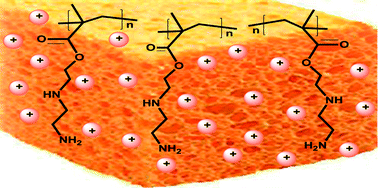A new proton sponge polymer synthesized by RAFT polymerization for intracellular delivery of biotherapeutics†
Abstract
A spermine-like polymer was synthesized via reversible addition–fragmentation chain transfer polymerization as a potential endosomal escaping agent. A new methacrylate monomer, 2-((tert-butoxycarbonyl)(2-((tert-butoxycarbonyl)amino)ethyl)amino)ethylmethacrylate (BocAEAEMA), was prepared and then polymerized via RAFT polymerization at constant monomer or initiator concentration at varying [M]/[R]/[I] ratios. In all polymerizations, ln[M]0/[M] increased linearly with time. The linear increase in Mn with monomer conversion was also observed. P(BocAEAEMA)s with controlled molecular weights and narrow molecular weight distributions were obtained. The in vitro cytotoxicity and proton sponge capacity of deprotected polymers P(AEAEMA) were investigated in comparison with a widely used endosomal-disruptive polymer, PEI. P(AEAEMA)s were found to possess proton sponge capacity comparable with PEI. More importantly, P(AEAEMA)s were not toxic on NIH 3T3 cells at concentrations where PEI (25 kDa) was highly toxic (0.4 μM and above). P(AEAEMA) was able to fully condense a DNA fragment at nitrogen/phosphate (N/P) ratios of 10 and above, as evidenced by gel electrophoresis. P(BocAEAEMA) was then chain-extended with a model sugar monomer, mannose-acrylate (ManAc), to yield P(AEAEMA)-b-P(ManAc) block copolymers, to potentially provide cell-recognition ability to the polyplex particles. Although the presence of the P(ManAc) block partially inhibited the interaction of P(AEAEMA) with DNA, P(AEAEMA)13-b-P(ManAc)7 was able to form polyplexes with DNA at N/P ratios ranging between 20/1 and 2/1. Dynamic light scattering measurements showed that while P(AEAEMA) (Mn = 5.5 kDa) and DNA formed polyplex particles having a hydrodynamic diameter (Dh) of 125 ± 51 nm, P(AEAEMA)13-b-P(ManAc)7 and DNA formed particles with a smaller Dh of 38 ± 10 nm.


 Please wait while we load your content...
Please wait while we load your content...